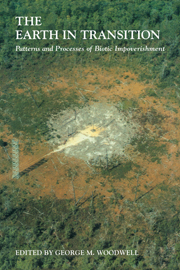Book contents
- Frontmatter
- Contents
- Preface
- Acknowledgments
- List of Contributors
- Part I Global Change and the Patterns of Impoverishment
- Part II Chronic Disturbance and Natural Ecosystems: Forests
- 8 The Restoration of Nonsuch Island as a Living Museum of Bermuda's Precolonial Terrestrial Biome
- 9 Patterns of Impoverishment in Natural Communities: Case History Studies in Forest Ecosystems – New Zealand
- 10 Changes in the Eucalypt Forests of Australia as a Result of Human Disturbance
- 11 Impoverishment in Pacific Island Forests
- 12 Deforestation in Brazilian Amazonia
- 13 Incentives for Sustainable Forest Management
- Part III Chronic Disturbance and Natural Ecosystems: Woodlands, Grasslands, and Tundra
- Part IV Chronic Disturbance and Natural Ecosystems: Aquatic and Emergent Ecosystems
- Part V Conclusion: Steps toward a World That Runs Itself
- Name Index
- Subject Index
12 - Deforestation in Brazilian Amazonia
Published online by Cambridge University Press: 24 November 2009
- Frontmatter
- Contents
- Preface
- Acknowledgments
- List of Contributors
- Part I Global Change and the Patterns of Impoverishment
- Part II Chronic Disturbance and Natural Ecosystems: Forests
- 8 The Restoration of Nonsuch Island as a Living Museum of Bermuda's Precolonial Terrestrial Biome
- 9 Patterns of Impoverishment in Natural Communities: Case History Studies in Forest Ecosystems – New Zealand
- 10 Changes in the Eucalypt Forests of Australia as a Result of Human Disturbance
- 11 Impoverishment in Pacific Island Forests
- 12 Deforestation in Brazilian Amazonia
- 13 Incentives for Sustainable Forest Management
- Part III Chronic Disturbance and Natural Ecosystems: Woodlands, Grasslands, and Tundra
- Part IV Chronic Disturbance and Natural Ecosystems: Aquatic and Emergent Ecosystems
- Part V Conclusion: Steps toward a World That Runs Itself
- Name Index
- Subject Index
Summary
Editor's Note: Why are ecologists concerned about the imminent destruction of the last of the tropical forests?
The answers are legion, so many as to seem diffuse, so powerful as to seem exaggerated and shrill, so fundamental as to seem obvious, and so demanding as to seem preemptive.
Forests are the great biotic flywheel that keeps the biosphere functioning more or less predictably. They are the major biotic component of the global carbon cycle, contain about three times as much carbon as the atmosphere, and their destruction contributes directly to the warming of the earth. Their presence determines the reflectivity of the earth over large areas, energy balance, water balance, nutrient fluxes, and air and water flows. They are, moreover, the major reservoir of biotic diversity on land: there is no habitat richer in species, none more promising as a source of succor for a swelling, scrambling, grasping human population uncertain as to where its great hopes lie. And yet, no habitat is being addressed more rapaciously than the tropical forests of Brazil.
Philip Fearnside is an ecologist with many years’ experience in research, writing, and teaching in Brazil. He writes here about one of the world's greatest tragedies and touches on the transitions in plant communities that accompany the process around the world. The shift from forest to grassland or lesser communities is common here as elsewhere under chronic disruption.
- Type
- Chapter
- Information
- The Earth in TransitionPatterns and Processes of Biotic Impoverishment, pp. 211 - 238Publisher: Cambridge University PressPrint publication year: 1991
- 9
- Cited by



